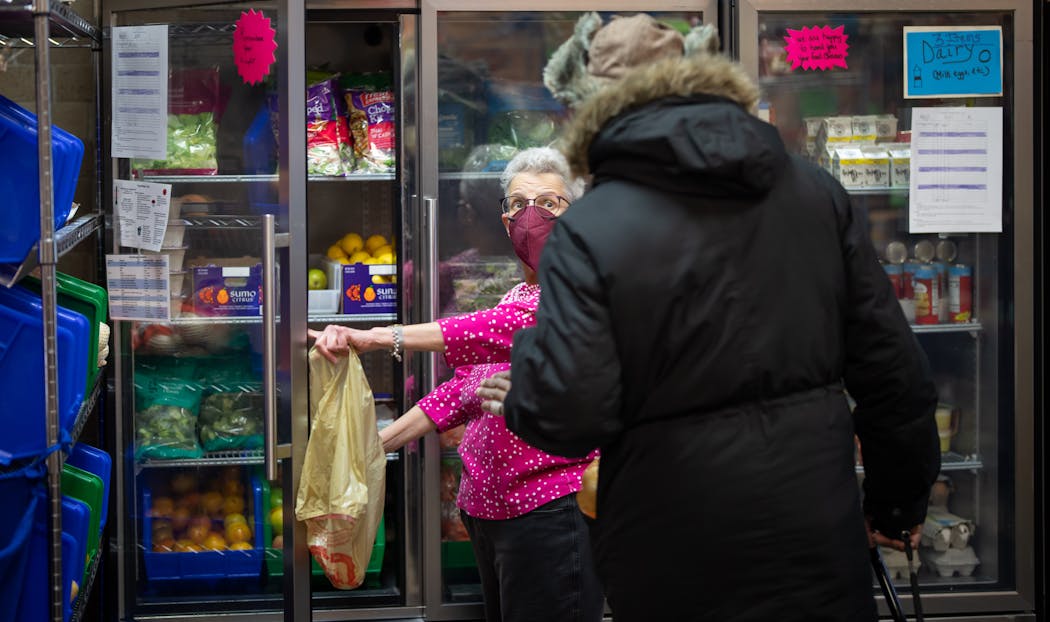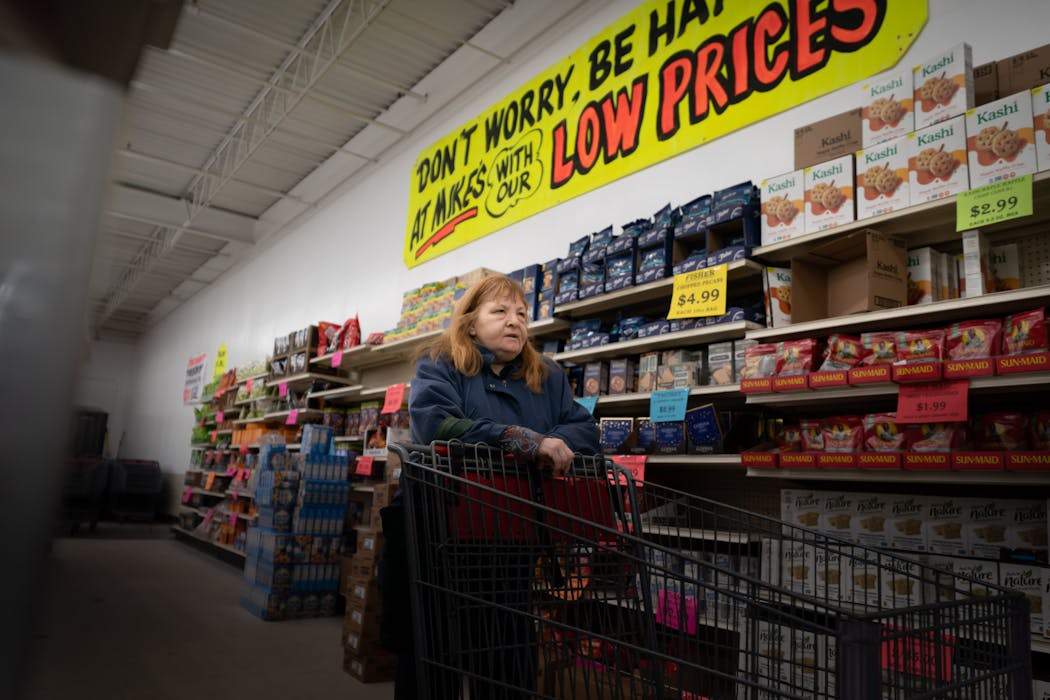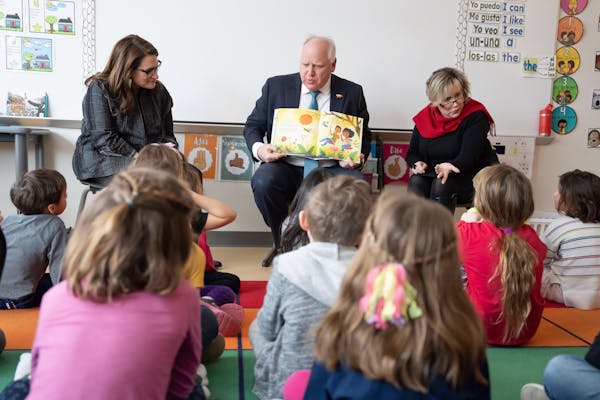Fresh produce, milk and other groceries stocked the Senior Food Shelf in northeast Minneapolis. Standing in front of them, Jane Baron sobbed.
The retired nurse could no longer afford her rent, bills and food. So for the first time, in her late 60s, she sought help.
"I found myself in a financial place I never dreamed I'd be," said Baron, now 71. "Not only was it tough financially, but it had a real emotional toll on me."
Years ago, she enjoyed a comfortable lifestyle in a double-income household with two kids. But after a divorce, credit card debt and a fixed income in retirement, she found herself in the once-unimaginable position of visiting a food shelf so she wouldn't go hungry.
Now she and an increasing number of aging Minnesota women struggle to stay above the poverty line, especially after the added effects of inflation.
Women older than 65 have long experienced higher poverty rates than men. But there also was a noticeable increase in 2021, the most recent year of available data in the American Community Survey, pushing that gap even wider.
The rate, reflecting the share of the age group in poverty, obscures the issue that this group is also much larger. There are about 40% more women age 65 and older in Minnesota living in poverty now than a decade ago, while the overall population in that age group has grown only about 25%.
Baron, who lives on $2,500 a month, still picks up free groceries monthly, but she also volunteers at the same food shelf she once was ashamed to visit.
"I'm relieved knowing it's there," she said. "I know I don't have to go without food."
She feels better off than many of her peers.
In fact, Sheila Parrott, a Senior Food Shelf greeter, and her husband live on Social Security and their part-time incomes. Her dream of retirement is out of reach.
"I'm 65," she said. "I have to work."
Rising costs
Women age 65 and older often enter their retirement years with less Social Security income as a result of the gender pay gap during their career and time out of the workforce to care for children. That also reduces their ability to save for retirement.
Even those who did adequately save aren't immune. End-of-life care for a spouse, for example, can wipe out life savings. Just the current rapidly rising cost of food, rent and health care may deplete a nest egg.
And these days, more than in previous generations, many more single or divorced women enter their retirement on one income.
"In general, in America and in Minnesota, we really have a retirement crisis," AARP state director Cathy McLeer said.
Minnesota state demographer Susan Brower said further data analysis could show what caused the 2021 uptick of older women in poverty, potentially pandemic job losses or the start of a longer-term trend. But women do face certain unique challenges in old age.
"Just the fact that women tend to make less when they're working and tend to live longer puts them in a more vulnerable position than men because their savings need to last longer," Brower said.
In Minnesota, about 19% of women 65 and older count on Social Security for at least 90% of their income, versus about 12% of men, with payments based on earnings, according to AARP Minnesota. And almost half of women 65 and older use Social Security for at least 50% of their income, compared to about a third of men.
Minnesota's average Social Security benefit is $1,740 a month. For women, it's $1,545 a month. For women of color, it's even less.
"Broadly, when you look at inequities that exist, the wage inequities follow you into retirement," said Dan Doonan, executive director of the National Institute on Retirement Security.
Uncertain future
Many women on the cusp of retirement feel insecure about having enough income to pay bills, manage rising health care costs and save for retirement, according to a September nationwide AARP survey.
The survey found that among women age 50 to 64, fewer than one in 10 are very confident they will have enough to live comfortably throughout their retirement. In fact, these women are nearly three times more likely to not be confident at all (25%).
Those who lack confidence in funding a comfortable retirement cite insufficient Social Security benefits, not enough retirement savings, an uncertain economy and low wages that made retirement saving impossible.
AARP advocates for the Minnesota Secure Choice Retirement Program Act, a public-private partnership to automatically enroll employees who otherwise don't have access to retirement plans. Employees — unless they opt out — would have a chance to save via an IRA or a state-sponsored, multiple-employer retirement plan.
Since the 1980s, employers have opted out of defined benefit plans — also known as pensions with a fixed, pre-established benefit at retirement — but Doonan said the workforce shortage is sparking some companies to consider resurrecting such plans to attract and retain workers.
Policymakers and community leaders are uniting as part of the Age-Friendly Minnesota effort to make systems responsive to older adults before the first wave of baby boomers reach age 85 after 2030.
Many of them will need costly assistance. Home care averages $60,000 a year for 44 hours per week, according to the Minnesota Department of Human Services. A nursing home can run six figures annually. Seniors who have exhausted savings must turn to Medicaid for long-term care.
Doing without
Margaret Kaplan, Housing Justice Center president, hears every day about women sacrificing necessities to make rent.
"That just should not be happening," she said. "In order to have a place to live, someone shouldn't have to forgo food or health care or transportation."
When Jan Bragelman learned that a doctor-prescribed ointment cost $250, she decided to do without it.
Bragelman, 74, has about $400 left of her $2,066 Social Security monthly income after paying rent for her affordable housing unit.
"It's not a lot," she said, "especially with inflation."
The retired nurse said she lost her retirement savings after investing with a fraudulent money manager, and she never had a pension. She's part of a group of seniors seeking rent caps for affordable housing after her landlord, Dominium, imposed a 12.5% rent hike.
Older women struggling with their finances face stark choices, particularly if they can no longer work.
"I worked a part-time job that I loved, but I had to give it up for health reasons," said Char Golgart, 72, Bragelman's neighbor. "There's a lot of people in that situation."
Golgart canceled cable and internet, has no credit cards and lives on $300 a month after rent.
Southeast Seniors, a Minneapolis neighborhood nonprofit, recently has fielded more requests to help older adults with paying energy costs, finding food shelves and financing needed but expensive home repairs.
"We work with a large population that's solo: living alone and not having the close social connections with family, friends and neighbors that were more common in the past," Southeast Seniors Executive Director Betsy Snyder said.
Roz Witkowski, 67, stretches nearly $2,000 in monthly income from Social Security and a part-time job by shopping at Mike's Discount Foods. The store offers closeouts and short-dated items that are cheaper than the grocery store where she works — even with her employee discount.
After two abusive husbands and an ADHD diagnosis in her 40s, she was unable to work full-time. She now struggles to maintain the Minneapolis house her mother left to family.
Witkowski feels overwhelmed at the thought of eventually not being able to work. But then she thinks of a friend who makes even less — $1,000 a month — and doesn't leave the house to avoid spending.
Baron, the retired nurse, plans to move into senior rental housing to age in a community. Her adult son will subsidize her rent as she continues to pay off debt accumulated during her marriage years earlier.
She grapples with burdening her son but feels fortunate to even have family support.
"He'll be there for me," she said.
Data editor MaryJo Webster contributed to this report.

Minnesota Department of Health rescinds health worker layoffs

Eco-friendly house on 30 acres near Marine on St. Croix listed at $1.6M

DOGE cuts federal money for upgrades at Velveeta plant in New Ulm




